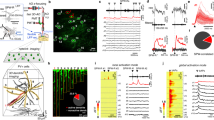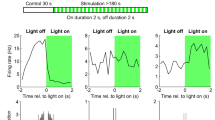Abstract
Processing of neuronal information depends on interactions between the anatomical connectivity and cellular properties of single cells. We examined how these computational building blocks work together in the intact rat hippocampus. Single spikes in dentate granule cells, controlled intracellularly, generally failed to discharge either interneurons or CA3 pyramidal cells. In contrast, trains of spikes effectively discharged both CA3 cell types. Increasing the discharge rate of the granule cell increased the discharge probability of its target neuron and decreased the delay between the onset of a granule cell train and evoked firing in postsynaptic targets. Thus, we conclude that the granule cell to CA3 synapses are 'conditional detonators,' dependent on granule cell firing pattern. In addition, we suggest that information in single granule cells is converted into a temporal delay code in target CA3 pyramidal cells and interneurons. These data demonstrate how a neural circuit of the CNS may process information.
This is a preview of subscription content, access via your institution
Access options
Subscribe to this journal
Receive 12 print issues and online access
$209.00 per year
only $17.42 per issue
Buy this article
- Purchase on Springer Link
- Instant access to full article PDF
Prices may be subject to local taxes which are calculated during checkout





Similar content being viewed by others
References
Collier, T.J., Miller, J.S., Travis, J. & Routtenberg, A. Dentate gyrus granule cells and memory: electrical stimulation disrupts memory for places rewarded. Behav. Neural Biol. 34, 227–239 (1982).
Jung, M.W. & McNaughton, B.L. Spatial selectivity of unit activity in the hippocampal granular layer. Hippocampus 3, 165–182 (1993).
Rolls, E.T. . in Neural Models of Plasticity (eds. Byrne, J. H. & Berry, W. O.) 240–265 (Academic, San Diego, 1989).
Sloviter, R.S. The functional organization of the hippocampal dentate gyrus and its relevance to the pathogenesis of temporal lobe epilepsy. Ann. Neurol. 35, 640–654 (1994).
Mody, I., Lambert, J.D. & Heinemann, U. Low extracellular magnesium induces epileptiform activity and spreading depression in rat hippocampal slices. J. Neurophysiol. 57, 869–888 (1987).
Lothman, E.W., Stringer, J.L. & Bertram, E.H. . in The Dentate Gyrus and its Role in Seizures (eds. Ribak, C. E., Gall, C. M. & Mody, I.) 301–313 (Elsevier, Amsterdam, 1992).
Boss, B.D., Peterson, G.M. & Cowan, W.M. On the number of neurons in the dentate gyrus of the rat. Brain Res. 338, 144–150 (1985).
Amaral, D.G., Ishizuka, N. & Claiborne, B. Neurons, numbers and the hippocampal network. Prog. Brain Res. 83, 1–11 (1990).
Amaral, D.G. & Dent, J.A. Development of the mossy fibers of the dentate gyrus: I. A light and electron microscopic study of the mossy fibers and their expansions. J. Comp. Neurol. 195, 51–86 (1981).
Frotscher, M., Soriano, E. & Misgeld, U. Divergence of hippocampal mossy fibers. Synapse 16, 148–160 (1994).
Acsady, L., Kamondi, A., Sik, A., Freund, T. & Buzsáki, G. GABAergic cells are the major postsynaptic targets of mossy fibers in the rat hippocampus. J. Neurosci. 18, 3386–3403 (1998).
Maccaferri, G., Toth, K. & McBain, C.J. Target-specific expression of presynaptic mossy fiber plasticity. Science 279, 1368–1370 (1998).
Toth, K., Suares, G., Lawrence, J.J., Philips-Tansey, E. & McBain, C.J. Differential mechanisms of transmission at three types of mossy fiber synapse. J. Neurosci. 20, 8279–8289 (2000).
McNaughton, B.L. & Morris, R.G.M. Hippocampal synaptic enhancement and information storage within a distributed memory system. Trends Neurosci. 10, 408–415 (1987).
Markram, H., Lubke, J., Frotscher, M. & Sakmann, B. Regulation of synaptic efficacy by coincidence of postsynaptic APs and EPSPs. Science 275, 213–215 (1997).
Magee, J.C. & Johnston, D. A synaptically controlled, associative signal for Hebbian plasticity in hippocampal neurons. Science 275, 209–213 (1997).
Henze, D.A., Urban, N.N. & Barrionuevo, G. The multifarious hippocampal mossy fiber pathway: a review. Neuroscience 98, 407–427 (2000).
Henze, D.A. et al. Intracellular features predicted by extracellular recordings in the hippocampus in vivo. J. Neurophysiol. 84, 390–400 (2000).
Csicsvari, J., Hirase, H., Czurko, A. & Buzsáki, G. Reliability and state dependence of pyramidal cell-interneuron synapses in the hippocampus: an ensemble approach in the behaving rat. Neuron 21, 179–189 (1998).
Ranck, J.B. Jr. Studies on single neurons in dorsal hippocampal formation and septum in unrestrained rats. I. Behavioral correlates and firing repertoires. Exp. Neurol. 41, 461–531 (1973).
Galarreta, M. & Hestrin, S. Spike transmission and synchrony detection in networks of GABAergic interneurons. Science 292, 2295–2299 (2001).
Skaggs, W.E., McNaughton, B.L., Wilson, M.A. & Barnes, C.A. Theta phase precession in hippocampal neuronal populations and the compression of temporal sequences. Hippocampus 6, 149–172 (1996).
Rolls, E.T. . in The Computing Neuron (eds. Durbin, R., Miall, C. & Mitchison, G.) 125–159 (Addison-Wesley, Wokingham, 1989).
Lisman, J.E. Relating hippocampal circuitry to function: recall of memory sequences by reciprocal dentate-CA3 interactions. Neuron 22, 233–242 (1999).
Paulsen, O. & Sejnowski, T.J. Natural patterns of activity and long-term synaptic plasticity. Curr. Opin. Neurobiol. 10, 172–179 (2000).
Buzsáki, G. Two-stage model of memory trace formation: a role for “noisy” brain states. Neurosci. 31, 551–570 (1989).
Chattarji, S., Stanton, P.K. & Sejnowski, T.J. Commissural synapses, but not mossy fiber synapses, in hippocampal field CA3 exhibit associative long-term potentiation and depression. Brain Res. 495, 145–150 (1989).
Salin, P.A., Scanziani, M., Malenka, R.C. & Nicoll, R.A. Distinct short-term plasticity at two excitatory synapses in the hippocampus. Proc. Natl. Acad. Sci. USA 93, 13304–13309 (1996).
Alle, H., Jonas, P. & Geiger, J.R. PTP and LTP at a hippocampal mossy fiber-interneuron synapse. Proc. Natl. Acad. Sci. USA 98, 14708–14713 (2001).
Doherty, J. & Dingledine, R. Reduced excitatory drive onto interneurons in the dentate gyrus after status epilepticus. J. Neurosci. 21, 2048–2057 (2001).
Scharfman, H.E., Kunkel, D.D. & Schwartzkroin, P.A. Synaptic connections of dentate granule cells and hilar neurons: results of paired intracellular recordings and intracellular horseradish peroxidase injections. Neuroscience 37, 693–707 (1990).
Urban, N.N., Henze, D.A. & Barrionuevo, G. Revisiting the role of the hippocampal mossy fiber synapse. Hippocampus 11, 408–417 (2001).
Marshall, L. et al. Hippocampal pyramidal cell-interneuron spike transmission is frequency dependent and responsible for place modulation of interneuron discharge. J. Neurosci. 22, RC197 (2002).
Lorincz, A. & Buzsáki, G. Two-phase computational model training long-term memories in the entorhinal-hippocampal region. Ann. NY Acad. Sci. 911, 83–111 (2000).
Tank, D.W. & Hopfield, J.J. Neural computation by concentrating information in time. Proc. Natl. Acad. Sci. USA 84, 1896–1900 (1987).
Bi, G.Q. & Poo, M.M. Synaptic modifications in cultured hippocampal neurons: dependence on spike timing, synaptic strength, and postsynaptic cell type. J. Neurosci. 18, 10464–10472 (1998).
O'Keefe, J. & Recce, M.L. Phase relationship between hippocampal place units and the EEG theta rhythm. Hippocampus 3, 317–330 (1993).
Harris, K.D. et al. Spike train dynamics predicts theta-related phase precession in hippocampal pyramidal cells. Nature (in press).
Vanderwolf, C.H. Cerebral activity and behavior: control by central cholinergic and serotonergic systems. Int. Rev. Neurobiol. 30, 225–340 (1988).
Ylinen, A. et al. Sharp wave-associated high-frequency oscillation (200 Hz) in the intact hippocampus: network and intracellular mechanisms. J. Neurosci. 15, 30–46 (1995).
Hara, K. & Harris, R.A. The anesthetic mechanism of urethane: the effects on neurotransmitter-gated ion channels. Anesth. Analg. 94, 313–318 (2002).
Harris, K.D., Henze, D.A., Csicsvari, J., Hirase, H. & Buzsáki, G. Accuracy of tetrode spike separation as determined by simultaneous intracellular and extracellular measurements. J. Neurophysiol. 84, 401–414 (2000).
O'Keefe, J. & Dostrovsky, J. The hippocampus as a spatial map. Preliminary evidence from unit activity in the freely-moving rat. Brain Res. 34, 171–175 (1971).
Acknowledgements
This work was supported by grants from the National Institutes of Health (NS34994, MH54671, MH12403, NS43157, 5P41RR009754).
Author information
Authors and Affiliations
Corresponding author
Ethics declarations
Competing interests
The authors declare no competing financial interests.
Rights and permissions
About this article
Cite this article
Henze, D., Wittner, L. & Buzsáki, G. Single granule cells reliably discharge targets in the hippocampal CA3 network in vivo. Nat Neurosci 5, 790–795 (2002). https://doi.org/10.1038/nn887
Received:
Accepted:
Published:
Issue Date:
DOI: https://doi.org/10.1038/nn887
This article is cited by
-
Distinguishing examples while building concepts in hippocampal and artificial networks
Nature Communications (2024)
-
Early endocannabinoid-mediated depolarization-induced suppression of excitation delays the appearance of the epileptic phenotype in synapsin II knockout mice
Cellular and Molecular Life Sciences (2024)
-
Assessments of dentate gyrus function: discoveries and debates
Nature Reviews Neuroscience (2023)
-
Phase information is conserved in sparse, synchronous population-rate-codes via phase-to-rate recoding
Nature Communications (2023)
-
Enhanced excitability but mature action potential waveforms at mossy fiber terminals of young, adult-born hippocampal neurons in mice
Communications Biology (2023)



